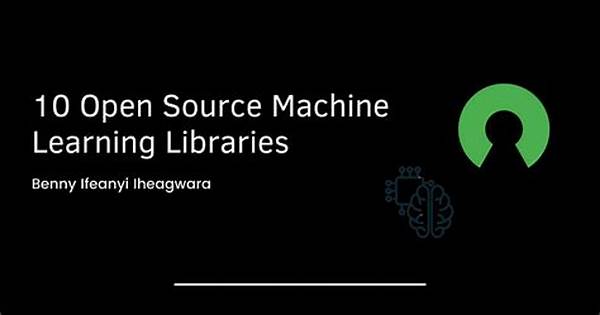H1: Innovative Open-Source Machine Learning Libraries
In the ever-evolving realm of technology, machine learning has emerged as a pivotal force, reshaping countless industries, from healthcare to finance. Central to this revolution are innovative open-source machine learning libraries. These libraries have democratized access to machine learning tools, allowing developers, researchers, and hobbyists to experiment and innovate without the constraints of proprietary software. This open-source paradigm not only fosters a collaborative environment but also accelerates the pace of technological advancements. Statistics reveal that the use of open-source software in enterprise IT stacks has surged by more than 95% over the past decade, highlighting their impact.
Imagine a world where problem-solving is as simple as calling a function. Open-source machine learning libraries make this possible. They package complex algorithms into user-friendly interfaces, ensuring that even those without a deep understanding of machine learning can leverage their benefits. The beauty lies in their accessibility and adaptability. With open-source, you can dive deep into the code, modify it to suit your needs, and contribute improvements, driving innovation further.
What sets innovative open-source machine learning libraries apart is their community-centric model. Every addition, improvement, and feature is born out of a collective effort. This ensures rapid bug fixes, updates, and support, all fueled by a dedicated group of enthusiasts and experts. With countless libraries available at your fingertips, the only limit is your imagination. From educational to practical applications, these libraries provide a solid foundation for building more complex machine learning models.
H2: Exploring the Top Innovative Open-Source Libraries
Now, let’s delve deeper into the purpose of these remarkable tools. Open-source machine learning libraries serve as the backbone for countless innovations, enabling everyone from seasoned data scientists to curious beginners to harness the power of AI. By offering transparent, modifiable, and distributable software, these libraries make AI research more accessible and less costly.
Pioneering libraries like TensorFlow and PyTorch are revolutionizing the AI industry. Their flexibility and extensive resources provide developers with limitless opportunities to innovate and improve their machine learning processes. Such libraries constantly integrate the latest research findings, ensuring users always have access to cutting-edge technology.
The collaborative nature of open-source projects significantly accelerates the pace of technological advancement. When you use an open-source machine learning library, you’re not just a consumer; you’re a collaborator in a worldwide digital ecosystem. Contributions from various developers worldwide mean that the software continuously evolves, with new features and improvements added regularly.
Open-source libraries also offer a unique blend of quality and reliability. Seeing the code allows for rigorous peer reviews, which ensures that bugs are quickly spotted and corrected. This transparency builds trust, as anyone can verify the software’s integrity, making open-source libraries a preferred choice for mission-critical applications.
H2: Benefits of Choosing Open-Source LibrariesH3: Engaging with a Collaborative Community
By opting for innovative open-source machine learning libraries, users gain access to a wealth of knowledge and resources. Forums and online communities, driven by shared enthusiasm, provide instant support and rich learning resources. Engage with these communities, share your insights, and gain from others’ experiences.
UL: Innovative Open-Source Machine Learning Libraries – Topics
Introduction to Innovative Open-Source Machine Learning Libraries
Open-source machine learning libraries have become an essential resource in today’s tech-driven society, offering robust and versatile tools for data scientists and developers. By lowering barriers to AI, these libraries empower individuals to engage in the AI revolution, sparking innovations across industries. From Google’s TensorFlow to Facebook’s PyTorch, each library brings its flavor of accessibility, community support, and innovation.
These tools have turned ambitious visions into reality, speeding up the time from creation to implementation. Open-source libraries are not only educational resources but catalysts for disruptive technologies. They fuel curiosity and ambition, leading to the development of creative solutions to complex challenges. Join the revolution, delve into the open-source world, and unleash the future’s possibilities.
H2: The Power of Community in Open-Source
As we further analyze innovative open-source machine learning libraries, it’s important to recognize the role of community engagement. These communities are the heart and soul of open-source, contributing time, skills, and ideas to ensure continuous improvements.
H3: Innovations Driven by Collaboration
The collaborative model propels innovation forward. By expanding on each other’s work, developers create a cycle of constant enhancement. This synergy not merely benefits software but fosters a culture of learning, mentoring, and shared success.
Ultimately, innovative open-source machine learning libraries represent an exciting frontier in the technological landscape. They invite us all to participate, learn, and contribute to a collective journey towards technological advancement. In an era where open collaboration is key, these libraries are paving the path forward, ensuring that technological innovation is within reach for everyone.

